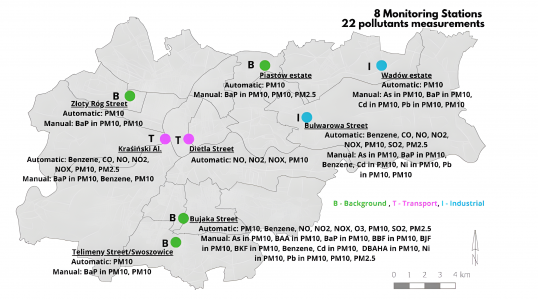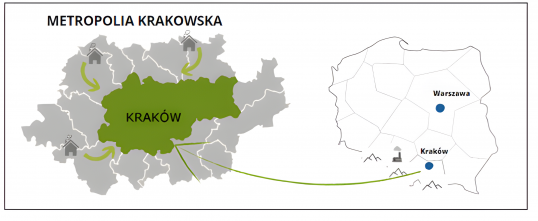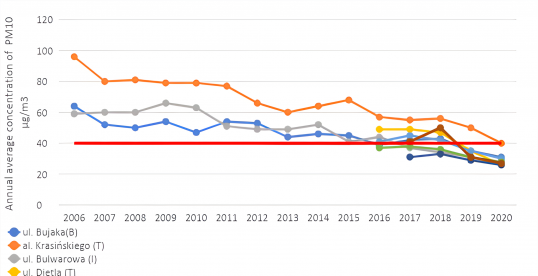Kraków was known as one of the cities with the worst air quality in Europe. About 20 years ago, inhabitants as well as city authorities decided that this was no longer acceptable. The city started an extensive campaign to improve air quality by delivering financial and practical support to citizens by changing their home heating system. Furthermore, the city also cooperated with surrounding municipalities to prevent the inflow of air pollution from outside the city limits.
This resulted in a significant drop of harmful air pollutants. However, there is still work to be done. The results achieved so far are boosting the city’s confidence that further improvements are feasible. “Tomorrow is green,” as Kraków puts it.
Starting situation
For years, the acceptable European target levels of particulate matter and other pollutants were exceeded in Kraków. The critical state of air quality was caused in particular by low local emission sources and emissions from nearby towns and villages. The country's historical and political dependence on coal has also played a significant negative role.
It was intensified by unfavourable geo-climatic conditions, such as atmospheric silence in winter, thermal inversion, unfavourable air humidity and location in a valley surrounded by hills.
Achieving the required air quality standards has become a priority for the authorities of the city of Kraków.
Implementation
One element of the air quality improvement strategy in Kraków is the Air Protection Programme, which has been adopted as an act of local law. A ban on the use of solid fuels has been in force in Kraków since 1 September 2019. This restriction turned out to be a key element in the fight to improve air quality in Kraków.
As part of the recovery programme, the main threats were diagnosed and the share of emission sources in concentrations was determined, goals were set, and the costs and sources of financing were identified.
The need to drastically reduce emissions from the municipal and housing sector turned out to be of key importance. Emissions from coal and wood combustion in domestic stoves, boiler rooms and fireplaces, which, as shown by analyses, have the largest share in airborne dust concentrations.
In order to reliably assess the scale of the task, the city carried out an inventory of wood and coal-fired stoves, boiler rooms and fireplaces.
The priority for the Kraków authorities was to change the heating systems in the city as quickly as possible by eliminating old heating sources and replacing them with environmentally friendly systems, thus reducing the airborne particulate matter.
An agreement was concluded with the Małopolska Province, the Provincial Fund for Environmental Protection and Water Management in Kraków, and the suppliers of heat, electricity and gas in which the signatories offered financial help to the inhabitants of Kraków who decided to switch to a more ecological method of heating, i.e. removing their coal furnace and install modern, low-emission heating options.
Monitoring the air quality was an important factor to provide residents with access to more detailed information. The air quality condition is monitored by 8 reference stations, strengthened by the Chief Inspector of Environmental Protection who provided 5 out of 8 stations.

Activities in the field of environmental education were addressed to all age groups, including children, adolescents and the elderly. Outdoor events, picnics, training sessions, lectures, and presentations in the field of air protection were organised.
In addition to these measures, an Energy Advisory Centre was set up. The Centre provides comprehensive information on the city’s financial resources offered to residents and on the external units for the installation of RES, the modernisation of buildings or for the conversion of the heating system.
To enhance accessibility, city adviser teams visited disadvantaged groups of people and taught them how to replace a solid fuel stove with environmentally friendly heating and how to obtain funding for this investment.
Moreover, in the area of the Municipality of Kraków, energy advisers performed thermal imaging tests on single-family homes. The images were then sent to the inhabitants of the house or apartment, who could see where “heat escapes from the property”. This motivated many to invest in thermo-modernisation.
This action significantly contributed to the increase in the environmental awareness of the citizens.
How to tackle indirect emissions

Bad air quality is not only a result of direct emissions from the municipal and household sector in Kraków, but also results from inflow from a distance of several kilometres from the location of the emission source.
Therefore, the impact of the neighbouring communes and the implementation of a low-emission policy there, has become particularly important due to the large share of incoming emissions from the surrounding communes.
In order to establish good cooperation between the neighbouring municipalities and Kraków, the Kraków Metropolis Association was established, which acts as the Union of Integrated Territorial Investments — a tool proposed by the European Commission.
A Programme Council for Air Protection in the city was established, operating with the Mayor of the city of Kraków, which, as a specialist advisory commission, supported (and still supports) the activities of the city of Kraków in solving problems related to the improvement of the air condition in the city.
Members of the Council are outstanding scientists and experts on air protection, representatives of leading Kraków universities and scientific and research institutions.
As part of cooperation with the scientific community, several projects were carried out. These include an assessment of the improvement in air quality by introducing changes in traffic organisation, an evaluation of the Low Emission Zone introduced, as well as the MONIT-AIR project co-financed by the European Environment Agency in order to create an “integrated spatial data monitoring system for the improvement of air quality in Kraków”.
Challenges
Acquiring financial resources for the implementation of some of the tasks such as the grant programmes was difficult.
Another issue was changing the mindset of the citizens of Kraków. The issue of decommissioning a coal hearth was an abstract concept in the minds of most inhabitants. Burning coal in domestic stoves seemed as natural as using water or breathing. The challenge was to make the right steps for behavioural change.
It was the change in the way of thinking, as a result of educational campaigns conducted by the City of Kraków, also in cooperation with social organisations (NGOs), that finally led to the intensive involvement of the residents and has led to the success of improving air quality in the city.
During the process of changing the heating system, barriers appeared that made it difficult to replace a solid fuel-fired furnace with a modern ecological system.
With a number of barriers (technical, legal, social, other), each case was considered individually depending on the problem.
Results
Currently, almost all buildings in the city are heated in an environmentally-friendly manner. Without intensive cooperation with the residents, it would have been impossible to replace the furnaces in such a short time.
By the end of 2020, over 45,000 solid fuel furnaces have been replaced with environmentally-friendly heating sources and over 2,600 renewable energy installations have been installed.
Decommissioning of furnaces (2012-2019) means avoiding the burning of over 330,000 Mg of coal and the emission of 1,600 Mg of dust.
In addition to the 45 060 furnaces and boiler rooms closed due to the Low Emission Reduction Programme, the now more environmentally aware residents removed about 20 000 furnaces off their homes.
Even though the air quality in the city is not as the city would like it to be, Kraków has created a significant improvement in air quality, and thus contributed to the improvement of the quality and comfort of life of its residents.
Currently, all air quality monitoring stations record a significant decrease in the concentrations of pollutants in comparison to previous years.

Annual average concentrations of PM10 particulate matter in Kraków in 2006-2020
As shown in the chart above, the average annual concentrations of PM10 particulate matter, as the measures taken by the city authorities, gradually decreased and in 2020, all stations achieved the normative values for the average annual concentrations of PM10.
At the monitoring stations, lower concentrations of nitrogen oxides are also recorded. They are important in measuring the formation of smog in the city.
Further focus areas
The city is aware that despite the clear decline in pollutant concentrations, it still has a long way to go. Particularly important are the issues of reducing pollution from transport or inflow emissions from municipalities adjacent to the city which currently have the greatest impact on the air quality in the city.
The city’s goal is to intensively influence the neighbouring communes by sharing experiences and stimulating them to implement a low-emission policy.
Learnings and recommendations
The implementation of tasks required integrated decisions at the local, regional, and national levels.
Today, Kraków is an example of action for other Polish cities, which, like Kraków, are introducing restrictions on the use of poor-quality fuels and boilers that do not meet the relevant standards.
The city has determined key elements without which it would have been impossible to achieve the current result:
- Diagnosis of the problem, appropriate risk assessment, assessment of tasks for the implementation of designated tasks and resident support programmes
- Acquisition of financial funds
- Involvement of inhabitants in implementation processes to support behavioural change and increased environmental awareness.
- Supporting inhabitants through city grant programmes and helping solve barriers when changing the heating source
The indicator that confirms the fact that the city is implementing the right measures is the observed decrease in concentrations at monitoring stations.
